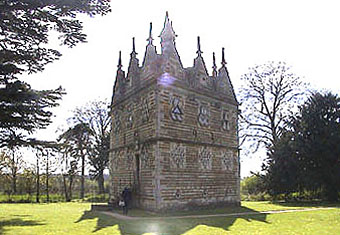
England is filled with curious buildings, follies as they’re commonly known, most of them the creation of wealthy landowners with time on their hands and a degree of imagination. Many of them are fake ruins, imitations of antiquity or classical architecture intended to add a degree of romance to a picturesque landscape. Some buildings are simply unusual, however, and one of the strangest of all is Sir Thomas Tresham’s Triangular Lodge near the village of Rushton, Northants. Nearly ever aspect of the building’s design and decoration relates to the number three, a reference to the Holy Trinity and Tresham’s religious convictions.
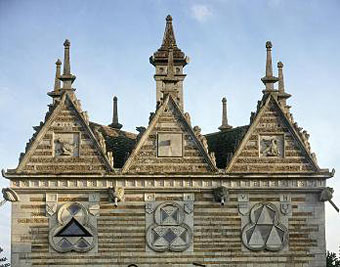
An extraordinary piece of symbolic architecture sits along a lonely country lane, about a mile from the village of Rushton. From a cursory glance at this small but ostentatious building, it bears all the hallmarks of being nothing more than a folly. Upon a closer inspection of both its structure and its history, however, a deeper explanation for the existence of this building gradually reveals itself.
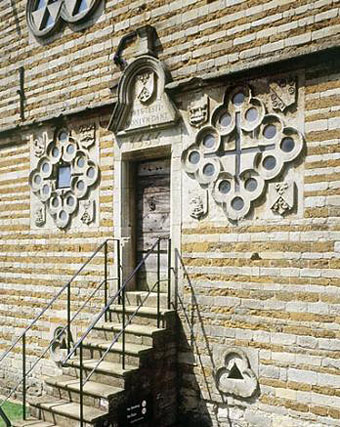
The Rushton estate was the principal seat of the Tresham family from 1437, and a large, country manor house was built in the late 15th century. With a staunchly Catholic background, Sir Thomas Tresham experienced a difficult and troubled life during the last two decades of the 1500s, and was imprisoned for much of the time because governments of the day felt threatened by his religious persuasion. It was during his prolonged captivity that Sir Thomas formulated the idea of making a covert declaration of his faith, having already smothered his cell walls with symbolic letters, dates, numbers and other religious scribbles.
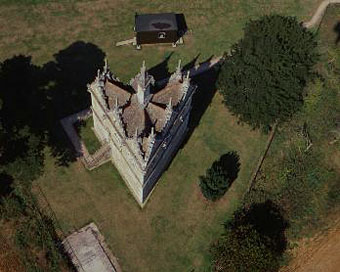
It was not uncommon for the Elizabethans and Jacobeans to incorporate ‘messages’ within their elaborate buildings, but to emblazon a house with so many clear references to the Trinity was an outrageous notion. Nonetheless, on his release in 1593, Tresham began designing the triangular lodge, as something of a shrine dedicated to his long suffering. The result was this small, colourful house adorned with dates, emblems, biblical passages, shields and skilfully carved gargoyles. Constructed on the basis of an equilateral triangle, the symbolism is apparent throughout the entire building, and all features relate back to the Holy Trinity and the Mass. On the three walls, there are three windows on each of the three floors, three roof gables, and even a triangular chimney adorned with Tresham trefoils.
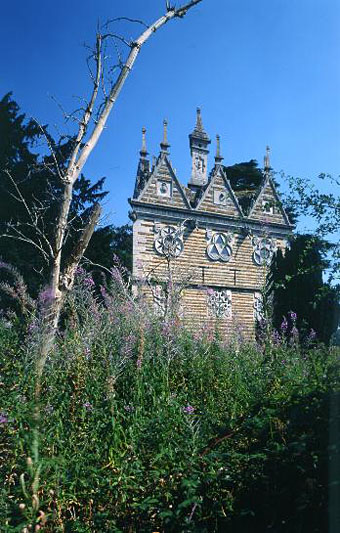
Inside, the house is remarkably plain, providing compact and simple accommodation for a gamekeeper or someone of similar status. The building is often referred to in the Rushton estate documents as The Warryners Lodge. Not a lavish palace, an impressive stately home, or a romantic country manor house, just a bizarre little dwelling created by the imaginative, perhaps slightly eccentric, mind of a devout Catholic man. Even if the religious connotations seem a bit heavy going and difficult to interpret, the fascination of identifying some of the emblems, and trying to understand how Thomas Tresham’s mind worked, invites a compelling investigation of the lodge.

Browsing through Robert Harbison’s The Built, the Unbuilt and the Unbuildable: In Pursuit of Architectural Meaning
http://mitpress.mit.edu/catalog/item/default.asp?ttype=2&tid=4784
http://www.wit.edu/Academics/HSSM/context/vol4/shopoff.html
which has the Triangular Lodge on pg. 71 …where a rabbit-keeper lived among abstruse theological meanings
and on pg 165 the Monument to Sir Isaac Newtown… the most magnificent unusable space ever imagined.
http://asd.londonmet.ac.uk/mahistory/rharbison.html
He’s also got a newer book called Eccentric Spaces
http://mitpress.mit.edu/catalog/item/default.asp?ttype=2&tid=3396
Nice to find out about all these things from reading you feuilleton as I have very minimal knowledge about architecture.
:-)
His newest yet to be published book is The Daily Telegraph Guide to English Parish Churches
http://www.amazon.com/gp/product/1845130669/qid=1142297881/sr=1-11/ref=sr_1_11/103-4874099-3457432?s=books&v=glance&n=283155
You’ll probably be interested to know that Alan Moore is very familiar with this building since it’s near Northampton. I forget the context but I know he’s mentioned it at least once in an interview.
I’ll probably be writing some more on follies, I have a guide to all the ones in Britain and there’s a lot more oddities hidden away. Unrealised architectural designs are another abiding fascination, a category that Boulée’s Newton Cenotaph certainly belongs in. Eccentric Spaces is a great title!
Three Panoramic photos of it here:
http://www.bbc.co.uk/northamptonshire/360/triangular_lodge.shtml
Oh, nice panoramas!
This house appeared on David Dimbleby’s how we built Britain last night (sunday 10th june) no doubt there’ll be a glossy book to accompany the series after its aired.
can you look inside – and if so – HOW??
It’s small and empty inside, and not very interesting. You can see some interior views from this Flickr user:
http://www.flickr.com/photos/leedad/sets/72157594238419067/